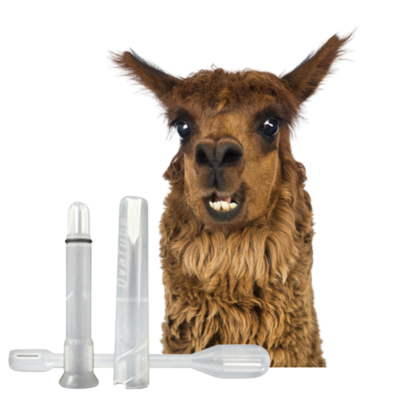
Safe, Simple and Mess Free Faecal Parasite Egg Monitoring For Alpacas and Llamas
As pets, companion animals, for commercial recreation or as a source of quality textiles, alpacas and llamas require constant monitoring for intestinal worms and parasites. StatSpin Ovatube® makes DIY faecal egg testing economical and practical for camelid owners and keepers.
Impact Of Intestinal Worms And Parasites On Camelid Herds
Veterinary research on alpacas suggests that around 90% of intestinal worms in an alpaca herd are produced by only 10% of the animals. So detecting which animals are infected is an efficient and cost effective approach to controlling the potential for wider parasite infestation.
Active intestinal parasite worms are difficult to detect because they are hidden inside an animal’s gut. Worm infections can be more easily diagnosed by microscopically examining an extract an animal’s faeces for the presence of parasite eggs, referred to by vets as oocysts or ovas.
Need For Clean, Convenient, Cost Effective ‘At-Home’ Parasite Egg Detection
In the past, lab based faecal parasite egg detection has relied on first mixing a small quantity of alpaca or llama faeces with either water or a ‘flotation solution’, and then microscopically searching a sample volume in a specialised glass slide counting chamber.
These methods are slow, messy, and relatively inaccurate, for most DIY at-home keepers of llamas and alpacas. Worse, they could miss detecting the oocysts causing the potentially deadly condition, coccidiosis, caused by the gut parasite, Eimeria macusensis.
Now For The Simple, Straightforward, On Site Parasite Egg Monitoring
The Statspin Ovatube Faecal Worm Detection Technique gives alpaca and llama keepers a worm egg monitoring test that’s not only quicker, cleaner and cost effective, it’s also more convenient than sending samples to off-site veterinary laboratories and then waiting for test results.
With Statspin Ovatube®, faecal parasite oocyst & ova detection is easily and accurately performed. A small sample of the animal’s faeces is first collected with the tool supplied with the Statspin kit. The sample is then mixed in the Ovatube with the special ‘flotation solution’.
A few minutes standing in the Ovatube Rack, and faecal debris will sink to the bottom of the Ovatube while the oocysts & ova float to the surface for collection and counting by examination under a laboratory microscope.
Alternatively, the Ovatube can be spun at low speed in a veterinary laboratory centrifuge in order to enhance oocyst recovery. However this requires a centrifuge specially adapted to hold 15ml tubes. In the experience of Vetlab’s experts, this centrifugation step entails significant extra cost and is not strictly necessary.
All this makes StatSpin OvaTube® the simple, centrifuge-free, parasite egg monitoring test that’s easy enough for the DIY camelid keeper to perform without the mess, and with little specialised equipment other than an economically priced microscope of the type readily available from Vetlab.
Statspin Ovatube: The Simple 4-Step Parasite Egg Detection Test
For keepers of alpacas and llamas, and for other animal care facilities where intestinal health is a priority, The Statspin Ovatube® Method provides for simple at-home, all-in-one, sampling, debris removal and parasite egg detection.
Follow The Simple, 4-Step, Mess Free Ovatube Test
1. Push the Ovatube sampling tool into a sample of faeces to collect around 1 gram of material.
2. Plunge the sample into the Ovatube, filled with approximately 15ml of floatation solution (specific gravity 1.27), and mix thoroughly to release any parasite eggs.
3. Insert the supplied filter tool into the Ovatube with a twisting motion to drive any large particles of organic material to the bottom of the Ovatube.
4. Place the Ovatube in the Staspin Rack and leave it to stand for 5 to 10 minutes. Finally, further twist the filter to raise the oocysts, floating on the solution, level with the top of the tube.
To recover and count any parasite eggs, place a microscope cover slip over the mouth of the Ovatube, then transfer it to a microscope slide for viewing under a microscope.
Using The Statspin Ovatube® Egg Count Test Is Simplicity Itself
The sampling tool ensures the right measure of sample is taken right from the centre of the faeces without contaminating hands, clothes or other laboratory equipment. The Statspin Ovatube ensures the right amount of a ‘floatation solution’ is always used.
Inserting the sampling tool, mixing faeces and solution, then simply leaving the rest to gravity, settles out the heavier faecal matter to the base of the Ovatube, while the parasite eggs float cleanly to the surface for easy assessment under the microscope.
While laboratory centrifugation after step 3 is an option, in the opinion of Vetlab’s experts, this is an unnecessary expense.
Professional Veterinary Endorsement For The Statspin Ovatube®
Published studies by the Companion Animal Parasitology Council (CAPC) showed that Ovatube performed as well as, and in some cases better than, standard parasite egg detection methods. The report concluded that: “Ovatube offers a much simpler and cleaner procedure than the standard centrifugal method”.
Research published in Veterinary Technician concluded that: “In our study, we found no significant diagnostic difference between CF [centrifugation] and standing flotation,” and “… that centrifugation did not increase parasite egg and oocyst detection. Thus, centrifugation was not needed…”
Everything you and the animals in your care need for Statspin Ovatube parasite egg detection is available from Vetlab Supplies, specialists in veterinary laboratory supplies. Just click Vetlab F.E.C Kits & Equipment
For further information visit our website www.vetlabsupplies.co.uk or call 01798 874567

